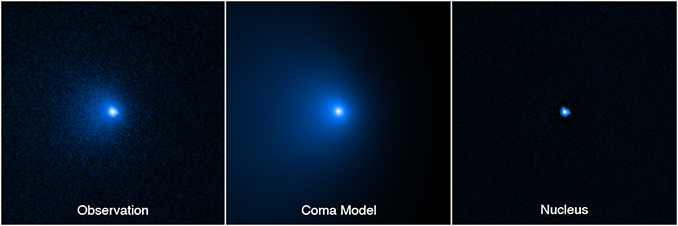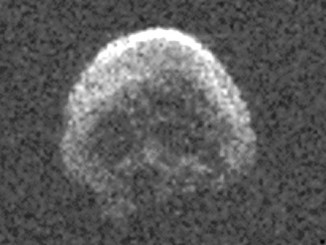
The nucleus of the largest known comet in the Solar System, C/2014 UN271 (Bernardinelli–Bernstein), has been measured by the Hubble Space Telescope to be 129 kilometres across.
The comet was first spotted in 2014 by the Dark Energy Survey (DES), conducted by NOIRLab’s Victor M. Blanco Telescope at the Cerro Tololo Inter-American Observatory in Chile, but it wasn’t until 2021 that University of Pennsylvania astronomers Pedro Bernardinelli and Gary Bernstein found the comet while sifting through the vast amounts of data collected by DES.
The comet is still far from the Sun and is currently located between the orbits of Uranus and Neptune, at a distance of less than three billion kilometres. The closest it will get to the Sun – what astronomers refer to as perihelion – is about 1.6 billion kilometres, which is beyond the orbit of Saturn, in 2031. It does not pose a threat to Earth.
“We’ve always suspected this comet had to be big because it is so bright at such a large distance,” says David Jewitt of the University of California, Los Angeles. “Now we confirm it is.”

Jewitt was part of a team led by Man-To Hui of the Macau University of Science and Technology who used Hubble on 8 January 2022 to image comet Bernardinelli–Bernstein. However, not even Hubble can distinguish the comet’s nucleus from its gaseous coma at such a great distance. The coma is the result of activity on and near the surface of the comet as it is gently warmed by the Sun. So the team used a computer model that described the expected size and shape of the coma at its current distance, based on the comet’s temperature (–211 degrees Celsius), which is warm enough for carbon monoxide ice to sublimate to form the coma. They then subtracted the model coma from the Hubble images. The starlike point that was left was the comet’s solid nucleus. From its brightness, and from comparisons with radio-wavelength observations made by the Atacama Large Millimeter/submillimeter Array (ALMA) in Chile, they were able to judge the amount of light the comet reflects, and then based on that and the comet’s brightness, calculate the diameter of its nucleus.
They found that the comet’s surface is extremely unreflective. “It’s blacker than coal,” says Jewitt. This means that to attain the brightness that it has, the comet’s nucleus must be even larger than the 100 kilometres that was predicted, in order to reflect enough light.
The comet’s diameter renders it the size of a small moon, but where does such a large comet come from? Astronomers believe there is a vast cloud of trillions of icy bodies at the very edge of the Solar System, extending possibly a light year away from the Sun. They call this the Oort Cloud. Sometimes one of these icy bodies can be nudged out of its orbit, perhaps by the gravity of a passing star, and begin falling towards the Sun. Comet Bernardinelli–Bernsteinwould have begun its journey in this fashion over a million years ago, and now it’s finally nearly here.




